The Four Levels Of Wargaming Part 5: Multilevel Games
July 28, 2014 by crew
Well, here it is, everyone. At last we come to the end of our series on the The Four Levels of Wargaming. Thanks so much to the Beasts of War community for all the positive feedback, questions, and interest. When I was first asked to write these, I was a little unsure of the reception I’d get because I was new to the community and discussing types of games not typically featured on the site. Rarely have I been so pleased to be proven so wrong.
Throughout the series, one recurring theme has been how to tie the context of a larger-scale “command style” game back to the narrative of the tactical games with which we’re all familiar. Immediately the gamer’s mind lurches to the inevitable conclusion: join the two models together into an epic “campaign game” setting. Depending on your genre, you could move battalions, cohorts, regiments, war bands, fleets, legions, or divisions around on your operational map and when opposing forces meet up, resolve the action with a tactical scenario.
Welcome to the madness of multilevel gaming. Our straightjackets come in sizes S through XXL, please allow 5-10 days for shipping.
The concept of multilevel gaming sounds simple enough, and when handled correctly, can be one of the most rewarding and immersive games of all. But quicksand is immersive too, and multilevel games can quickly get out of hand if players don’t watch out for certain pitfalls.
Any two of the “Four Levels of Wargaming” can theoretically be joined into a multilevel game, but some combinations are more common than others. For example, players could run all of Waterloo in a “command tactical” model, where the board represents four square miles and each playing piece is a brigade of 1000-2000 men. But when the action really gets thick, players could agree to resolve the action in “pure tactical” model (focusing on La Haye Sainte, for example). Fantasy is also great for this combination because the genre allows for very high-powered individuals in relation to the armies in which they stand. So while a 10,000-man battle can be resolved in a larger system, heroes, warlords, wizards, and dragons can square off in a separate “skirmish” table.
More commonly, however, players want to build an operational-level framework over a tactical-level series of games spanning weeks or months. A great example of this was recently presented on the June 1st Weekender XLBS, where Łukasz of Wolsung fame presented the “Alternate Bulgaria” campaign played at Micro Art Studios. Here, players moved armies around an operational-level map divided into Risk-like territory zones. When they met up, a Bolt Action game was built to resolve the clash. Results of the game were then applied back up into operational-level armies, and play continued.
For many players, this could be the ultimate source of gaming narrative. Through this overarching operational framework, players are compelled to formulate a “big-picture” plan in which their smaller tactical battles all play a part. You don’t have to read sci-fi fluff or military history to know exactly why this battle is more important than the one before, why this bridge is vital, which castles can be sacrificed, or which of your own space ports should be obliterated before they fall into enemy hands. Here you ARE the fluff, and no one understands the larger context better than you because you and your opponents are the ones the one creating it.
Before embarking on a multilevel game, however, ask yourself some questions in order to give your campaign the best chance of success.
One: Does the campaign need a referee? Look, no one likes to be the “designated driver” on party night. But since there aren’t really any published rule systems that seamlessly combine tactical and operational-level games into a single system, you may need an impartial arbiter to handle tricky situations. This is especially true when it comes to applying results of tactical games back up into the operational-level framework. “Impartial” may well mean “not playing,” an especially harsh sentence considering the referee will wind up doing much of the work.
Two: Do your players REALLY like the tactical game? This is important because it’s tough to estimate how many tactical games will eventually be required before the campaign is finished. Whatever your estimate, double it. If you’re using Kings of War to simulate the struggle between rival dukedoms, for example, you’d better have players that really love Kings of War because you could well be playing games three or four nights a week in order to advance the campaign at any kind of pace.
Three: What balance do the players prefer between the operational and tactical systems? On the one hand, you can run a highly-detailed series of tactical games with only the barest minimum of operational framework. In a Flames of War example, players could print a map of northern France, slap a grid on it, and use coins for force markers (heads for Allies, tails for Germans). A nickel is a 500-point army, a dime is a 1000-point army, and a quarter is a 2500-point army. These “coin divisions” moves three squares a turn, and when opposing forces wind up in the same square, set up a Flames of War game with forces based on the amount of money each side has in the square. Conversely, a highly-complex operational system including command hierarchies, logistics, transport infrastructure, air support allocation, special forces, partisans, and weather could be run with only a careful selection of the most important tactical engagements run at all. Having an agreement on where this operational-tactical balance will lie is important to the campaign’s success.
Even once all these questions are resolved, the multilevel campaign game still faces one potential challenge: its sheer size. If you try to run a tactical game every time opposing forces meet on your operational map, you’ll be playing a LOT of games and run the risk of player burn-out. Additionally, the vast majority of the tactical games dictated by operational map movements are going to be imbalanced to the point of silliness. Whereas two sides of a chess table may be balanced, the queen is always a vastly more powerful individual piece than the pawn and when you zoom down to resolve the queen vs. pawn “tactical battle,” the results can appear ridiculous. Assuming that players are allowed to deploy their operational-level forces more or less without restriction, the basic “physics” of the campaign are going to produce 300-point lists fighting 2000-point lists with startling frequency. But does anyone really want to play that kind of 40K, Bolt Action, or Kings of War game? Thirdly, scheduling can be a problem when two forces meet on the campaign map but one of the owning players can’t make it to the club to resolve the battle. These conflicts can logjam the campaign game long enough for the players to lose interest.
One suggestion is to have an operational-scale combat system ready to speed you through such bottlenecks, with both players’ permission, of course. This is especially handy if you’re using a published operational game system, simply use the combat resolution system that comes with the game. Or, if you don’t have an established system to handle these battles quickly, make up one of your own. Say a 1500-point Flames of War force tries to force a mountain pass controlled by a 500-point blocking force. Each army could roll a d6 for each 100 points in its force, with the defender getting an extra 5d6 for defending such a narrow position (here’s where that referee really comes in handy). In an open field that smaller force would present little more than a speed bump, but in the narrow valley it just might put up a damaging “300 of Thermopylae” style fight. I’ve also included a sample combat resolution chart at the end of this article, which can hopefully spark some ideas if nothing else. In any event, having a “shortcut system” ready and waiting will cut down on the number of games you’re playing, eliminate “pointless” games that would normally require an hour of setup for five minutes of play, and provide a way around annoying scheduling conflicts.
Another suggestion to resolve this issue was presented by vetruviangeek in the comments of the Operational-Level Gaming article. Rather than play out every tactical combat created by operational-level movement, players could select one combat per operational turn to be resolved in a full-fledged tactical game. These selection could be done in secret (folded slips of paper) to be revealed simultaneously. Or, the “loser” of that operational turn’s initiative might be compelled to announce first. If both players agree, the battle is set up and run. If they choose different combats, perhaps the initiative winner’s choice prevails or he has an advantage in some kind of roll-off, further modified by factors such as supply, intelligence, and air superiority. Such a “battle selection” mechanic also opens the nefarious possibility of players “nominating” combats they don’t actually care about, distracting their opponent with a big noisy tactical battle while their true thrust sneaks quickly along the flank on the operational-level map. Like they say in poker, “Don’t play the game. Play the man.”
Of course, this only scratches the surface of multilevel gaming, but more specific examples are tough to get into without focusing on one genre or another. So post below with questions, thoughts, or ideas, and help us expand on this immersive topic.
If you would like to write an article for Beasts of War then please contact me at [email protected] for more information!
"“Impartial” may well mean “not playing,” an especially harsh sentence considering the referee will wind up doing much of the work..."
Supported by (Turn Off)
Supported by (Turn Off)
"In any event, having a “shortcut system” ready and waiting will cut down on the number of games you’re playing..."
Supported by (Turn Off)










































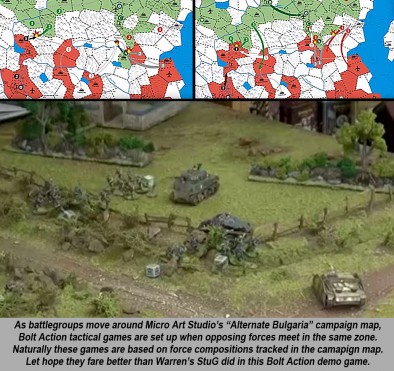
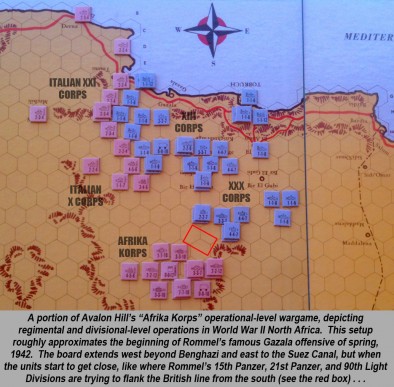
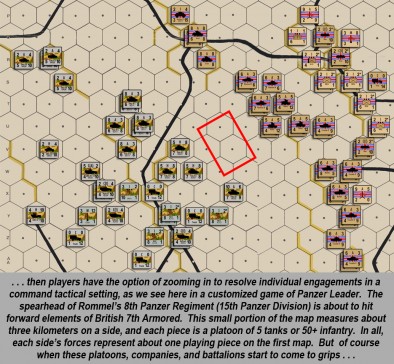

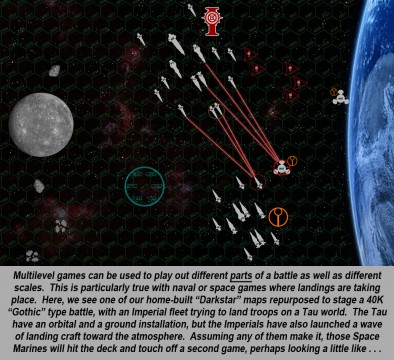
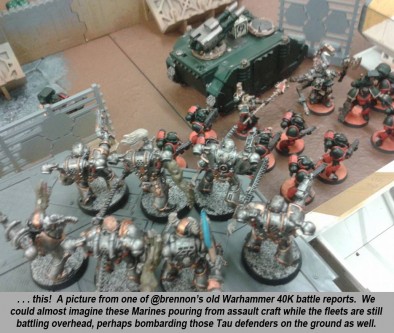



































An other great read – enjoyed the series
Thanks again, @rasmus , and thanks again for getting the comments going! 🙂
Reminds me of when we played a massive Warhammer 40,000 Campaign back a couple of editions. We had a whole planet to fight over and did most of our movement with interesting dice rolls and secret notes to the referee.
We then decided battles based on landscape and forces deployed, the occasional Kill Team mission for Special Ops kind of things and of course big battles when they were needed. It was a load of fun and nice to see the two layers working well together.
Oh and a referee is almost always needed!
BoW Ben
Thanks, @brennon . Reminds me of when FASA used to have a game called “Prefect” for their Renegade Legions universe, since the more I learn about 40K the more I start to see parallels between the two. Not only could you plug in their tactical games like Centurion (ground combat), Leviathan (naval space combat) and Interceptor (fighter combat), but they also had a map for a whole planet laid out in a hex grid formatted into a Goode projection. The only problem is that you needed a separate map for each planet. http://en.wikipedia.org/wiki/Goode_homolosine_projection#mediaviewer/File:Goode_homolosine_projection_SW.jpg Another neat thing they had was a… Read more »
I was just thinking about how to do a campaign game for a historical wargame last night. Those are some important thoughts listed, it does seem important to design things with enjoyment in mind and not go overboard in letting any of other factor take priority over that. Maybe making all armies be the same size (only one army can sit in a single hex or whatever you use), so that all games are competitive would be a good idea. You could always build in a support feature, so armies that have an adjacent friendly army get some kind of… Read more »
That’s a good idea, @frankelee . So when an attacking force moves to strike a much smaller defending force, the defender gets some sort of “operational reaction phase” to call in nearby reinforcements to meet the threat. This would make defenses much more reactive and flexible. It would also reduce the number of very uneven battles , and reduce the number of battles overall (you’d have a smaller number of larger battles instead of an endless chain of 100-pt vs. 200- point skirmishes you’d be playing until next Christmas). Maybe the smaller force would have a chance to simply “run… Read more »
Nice article again
My only advice for anyone trying to run a campaign is to keep it short and keep it simple. No matter what pledges of support you get for people to take part, if it runs too long then people will drop out.. If your writing your own campaign rules it is very easy to over complicate it with things you think need to be included but once the game starts you will realise that it just adds a layer of complexity that isn’t needed
Very well said, @torros . As I was writing this article, I kept trying to keep it from sounding like nothing but a list of warnings, the last thing thing I wanted was to discourage anyone. But like you say, the best favor a prospective multilevel gamer can do for him or herself is set up strict, modest parameters at the outset, and stick to them. Better to run a successful game that might be a little short . . . than to try to take on too much and the campaign ultimately fails when people get exhausted and stop… Read more »
A nice end to the run.
The unbalanced game is quite often the best games like in history some of the most important battles are very unbalanced and bloodiest with the most to lose/gain for both sides.
Thanks, @zorg , and very true about potential game imbalance. After all, an American Revolution campaign set in the bottom half of 1776 or the Vietnam War in early 1968 would be great. In such cases, the American Patriots or the Viet Cong win . . . simply by continuing to exist. 🙂 In a full “free-model” multilevel game, operational decisions and movements may well produce individual tactical battles that seem nigh on pointless. But if one side really feels that the best move is to sacrifice a 100 point army against a 1000 point force coming down a certain… Read more »
Yes yes and yes! This is the penultimate wargamer dream! What this article eloquently describes is how to run the tabletop versions of the Total War series, Hearts of Iron games, etc. Thanks for including the Kings of War references for us fantasy players as I do not know of any other fantasy set of rules that would allow a group to play out dozens of full-sized games in a weekend! I agree that the fantasy genre really handles these types of massive/epic contests where the survival of the entire world hangs in the balance. You can go from a… Read more »
Wow, where to begin? Thanks @stlwarrior for the kind words. Based on what I’ve seen in Kings of War demo games, I think you’d be right on the money when it comes to running KoW in a multilevel game . . . simply because it’s such a fast system. A group I used to run with long, long . . . long long ago 🙂 actually tried a fantasy multilevel game. We called it “Dark Kingdoms”, and used TSR’s old “Battlesystem” miniatures rules to run the fights. But it died the death that so many of these games do (and… Read more »
Been hoping for years of a program that would help with this, but most see no use for it, or tell you to go use something made for DOS.
A couple of articles ago, lfseeney , @torros actually had a pretty good idea in that regard when he forward me this link. It’s just a small patch of downloadable software, but allows higher-level “operational-scale” campaign movement for two players, double blind, without an umpire. When two units come within range of whatever detection range you specify, the units become visible to both players. Of course you’d still run your own tactical games on a table top.
http://delyall.tripod.com/berthier/berthier.html#sthash.4Ob1ECl2.dpuf
Another wonderful article. I believe some games do provide a light framework for ‘campaign’ play, however I believe you are correct in the assumption that there’s no specific ruleset that meshes the games (this I believe can easily be amended).
Thanks, @leoleez . You may be right about available games that provide a “light framework” for campaign play, I certainly can’t claim to have played or read about every game out there. 🙂 There is, for example, Victory Games’ “Pacific War” which **sort of** does this, as well as Decision Games’ monster “War in the Pacific” (nothing “light” about that one). Damn, now that I think of it, even Avalon Hill’s “Midway” has a larger “search and movement” grid map where American and Japanese players move their task forces around (complete with a screen between them, almost like “Battleship” .… Read more »
I think also that campaigns lead to differing armies on the tabletop. Light Cavalry and Scouts should be playing a bigger part in the armies and battles. In Napoleonic times light cav was used to scout and also either protect the retreating army from attack or harrying a retreated enemy so they couldn’t settle and regroup. In some wargames light cav and their ilk are seen in a pretty poor light as they arent brilliant at fighting and points can be better used elsewhere, but in a campaign they should become a invaluable part of your armies makeup if you… Read more »
That’s a very good point, @torros , and completely true. When a game expands outward, either in a multilevel setting or just a single level that happens to be larger, new categories of units come into the fore in ways they really can’t in a strictly tactical setting. I’d like to expand your point by including support units. I’ve lost count of the number of PanzerBlitz/Panzer Leader games I’ve lost because I didn’t have enough humble trucks, halftracks, and even horse-drawn wagons. Infantry, engineers, artillery, mortars, flak, they just can’t “walk” across these boards because they’re far too big. Larger… Read more »
A great conclusion to a fantastic series of articles (though I do have my doubts about the bit contributed by this VetruvianGeek chap. i hear he’s something of a bounder, and even managed to submit his user handle without checking that he had spelled ‘vitruvian’ properly…. 😉 )
You have expanded my wargaming horizons Oriskany, and so I take my warhelm/combat helmet/gloriously over the top be-feathered hat off to you. You are a scholar and a gentleman.
Seriously, @vetruviangeek , both you and @zorg were a huge help, if for no other reason than helping with a little 40k knowledge so I could address (even if only superficially) a much larger part of the BoW audience. And of course the alternate ideas about how to manage or reduce or circumvent or substitute the number of battles in a multilevel game was a massive contribution. Even ONE extra idea from an “outside” source makes this more of a community exercise in the exchange of ideas, and not one guy sitting at a desk tapping out inane ramblings. 🙂… Read more »
Put that helmet back on soldier snipers think always sniper.
Seriously now the info I gave you about 40K only scratches the surface even all the stuff I’ve read over the years probably only a drop in the sea would have to be a retired millionaire to get and read all the fluff out/coming out for 40K.
Certainly, @zorg , I’m getting a feel for how deep that ‘verse really is. The only things that have been keeping me afloat so far (besides great input from several members of the BoW community) is how much these Imperium guys sound like early war Soviets and how much the 40K universe in general seems to have with the old Renegade Legion universe from FASA. Anyway, between writing these articles, posting on a bunch of different threads, job, gaming, miniatures, girlfriend, etc . . . I just don’t have time to read a bunch of stuff of a ‘verse in… Read more »
Variety is the spice of life & gaming is the escapism of life.
Can’t argue with that . . . except maybe life should be the escape from gaming, and not the other way around. Priorities, man! Priorities! 🙂
LOL
Great article and series. Hope more opportunities for writing about wargames pop up.
Although. I’m spoiled. I’ve been learning at Oriskany’s wise knee for decades.
Wise knee? Okay, seriously everyone. Talk about getting spoiled, all these compliments and I won’t be able to get my head out the door. 🙂 Thanks for the kind words, @amphibiousmonster . It takes other gamers and a great community, though. Otherwise it’s just grouchy old grognards like me sitting in a room talking to themselves. As far as new articles go, I’m talking with the BoW guys now . . . but of course I can’t promise anything since it’s their site, their schedules, and their show. 🙂 (plus there’s that whole “new Ferrari” clause in my contract, and… Read more »
I would think you would be holding out for a Lanchester Armoured Car instead
That or a Rolls Royce. A guy’s gotta have his standards.
http://www.lonesentry.com/blog/wp-content/uploads/2011/01/rolls-royce-armored-car.jpg
As for recon elements… Not too long ago in a Panzerleader 1940 game, a single platoon of French Panhard armored cars altered the coarse of the game. In more of a counter-recon role, they shot up some German motorcycle sections that were getting ready to spot the hell out of French 75mms and redrilled 18 pounders.
That’s a tactical example, though, which is largely the extent of my experience..
Augh … those “redrilled” 18/25-pounders. What garbage. But in a game where the Germans are still rockin’ the 7.5 cm infantry guns, they can still put down some ferocious power. The only problem is that even in Panzer Leader 1940, German infantry platoons still have a DF of 8. So . . . yeah. You’re really hurting for good HE-class anti-infantry firepower. Those Panhards are awesome, I think 7th Panzer Division used them right up to the end of the war. You run across them in Barbarossa and 1942 Russian games if you’re careful. Love that Early War.
That resolution table may come in handy! 😉
Loved the articles. The whole serie was quite interesting and the idea of mixing different levels of wargaming really is appealing to me.
With the size of your armies, @happyhowler , that doesn’t surprise me. 🙂 You’ve probably put together enough orks to take on a planet. Glad you liked the table. Avalon Hill’s been coming out with Combat Resolution Tables (CRTs) for their games since the late fifties, and since then there have been a hundred different variations and flavors. Usually there’s “Defender wins” or “Attacker wins” or “Exchange,” mine adds a few more possible results to the mix. However, it’s very linear (notice the results staircase straight up across the odds columns), many CRTs try to put in some kind of… Read more »
I, for one, LOVE campaign games. I don’t really have the patience and organization to truly run one of my own; however, if I have someone willing to do the hard part I all for playing. They let me have the immediate and visceral thrill of a high intensity tactical games but the long term satisfaction that all my work has a point/goal. So thank you to all gamers willing to put one of these multilevel games together, I have a my own supply of the above mentioned straight jackets and provide them complimentary at the start of all new… Read more »
Thanks, @gladesrunner . I suppose campaign or multilevel games would have a certain appeal to former RPG players, as in some ways they are just expanded versions of a similar mechanic. Cross this bridge, go to that castle, stop at this tavern, oh sh** . . . we’re under attack! Zoom down to a smaller map to resolve the action. RPGers also expect some kind of “point” or overall “story,” which a multilevel game can also provide.
I agree with the RPG elements to a campaign – like you said it keeps a clean narrative going and can (and should be in my humble opinion) be extremely cinematic! I would argue that any good multilevel game SHOULD have the aforementioned point or overall story. While you can simply play a grand strategic game like it’s a game of Risk, why would you ignore the fun that banter, real diplomacy, actual double-dealing, and nasty threats can bring you!? RPG elements also really help bring your character “to life” as you, as a player, become the general / wizard… Read more »
I think this depends on the umpire and the players, but any campaign I have been involved in the players themselves have written those cinematic moments just through their actions during the game, Some of the big ones I have played in the referees have produced a weekly newsletter which lists the funny bits of the turn in a ‘red top’ newspaper type style. One game we played in was the players rebelling against a state so the newspaper produced was always done in the style of the government mouthpiece, these were only a single double sided sheet but fun… Read more »
I especially agree, @torros , when you say: “the players themselves have written those cinematic moments just through their actions during the game.” I have a lot of RPG friends that are hesitant to get into wargaming because “it all just combat, it’s not role playing.” As if the two were mutually exclusive? That’s **where** the roleplaying happens! Those kinds of stresses and life-and-death decisions is what really boils a person down and shows them for what they are, the “best of man vs. worst of man” kind of thing. Admittedly, though, some big-time strategic games really do get a… Read more »
Very good points, @stlwarrior . I started in wargaming in 1983, later switched largely to RPGs for about 15-20 years, then switched back. So I’ve spent time in both “worlds” and can definitely see the merits of both. Personally, I still love RPGs, I just can’t invest the time and effort to holding a group together that largely falls apart no matter what you do. That said, even as a “hard-core” wargamer, certain RPG elements have to be kept in play. We’ve played a PanzerBlitz game in Russia focusing on the GrossDeutschland Division. We basically made up “characters” (battalion commanders)… Read more »
Hi, i am digging back into this great series of article, and more i read, more i ask myself : ‘”but where can i find this Home-built Darkstar” ?
Is there a way to find it on the web ?